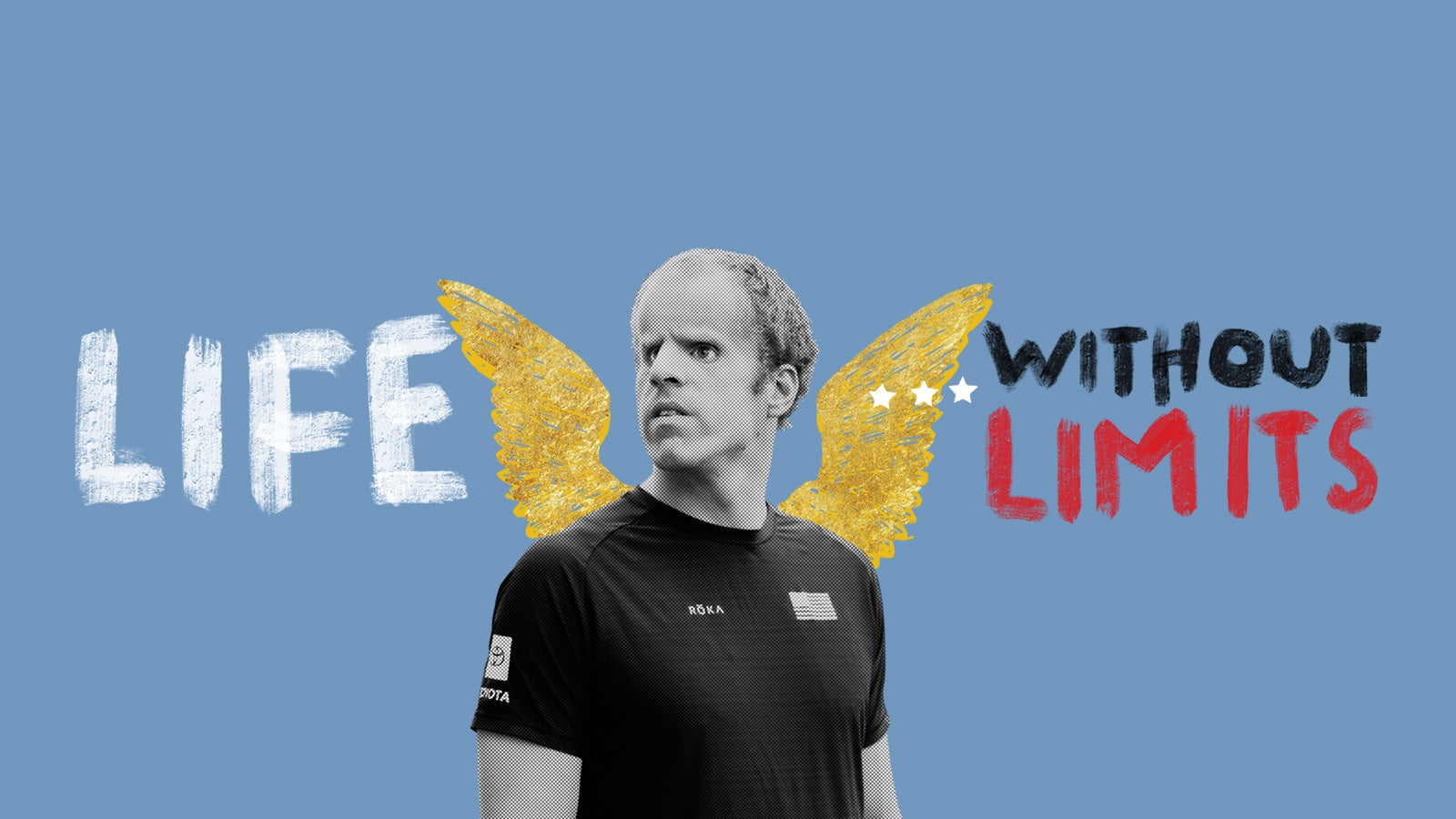
Life Without Limits

Summer 2019 | By Nicole Dudenhoefer ’17
At 7:30 a.m. every weekday, Kyle Coon ’13 begins his first of potentially four workouts for the day — a 4,000-meter swim. Next, he’ll run or bike for 90 minutes. And then, depending on the day, he’ll push through some more cardio and strength and conditioning sessions. On weekends he’ll complete one workout each day, either a long run or bike ride outdoors.
He’s followed the same routine without stop since January, when he became a resident at the Olympic Training Center in Colorado Springs, Colorado. Although the demands are high, Coon, a triathlete, knows they’re necessary to accomplish his goal of qualifying for the 2020 Paralympics in Tokyo.
“It’s an honor and privilege to be here at a facility where some of the greatest Olympic athletes have trained,” says Coon. “They only invite athletes that they think have a chance of making it to the Olympics or Paralympics, so it means a lot to me to be here.”
In order to make it to the 2020 Paralympics, Coon must put forth his best efforts in as many high-profile races as possible during a yearlong qualification period, which started June 28.
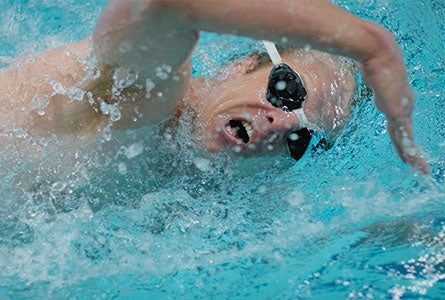
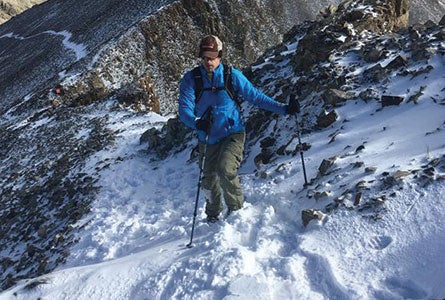
Only one visually impaired man and woman who earn the highest rankings by the International Triathlon Union’s standards will represent Team USA. This feat will require consistently high levels of athletic performance, but pushing himself to the edge of his capabilities has always come naturally for Coon.
At the time of publication, Coon is ranked No. 18 in the world among ITU’s visually impaired triathletes. In the U.S., his biggest competition for making the Paralympic team is ITU’s No. 2 visually impaired athlete Aaron Scheidies, an 11-time world champion who competed in the 2016 Summer Paralympics in Rio de Janeiro. In March, Coon trailed Scheidies by less than 2 minutes to earn second place in the Sarasota-Bradenton CAMTRI Paratriathlon American Championships. But Coon isn’t too worried. One workout and one race at a time, he’s steadily working to close the gap with Scheidies.
Although his schedule is demanding, Coon enjoys having a strict routine. Having lost his sight as a child, Coon can’t be spontaneous, not even for something as routine as a trip to a coffee shop or grocery store. For the most part, he knows what he’ll be doing for the next 24 hours. Life has demanded he develop a keen sense of foresight.

At 10 months old, Coon was diagnosed with bilateral sporadic retinoblastoma, the most common form of eye cancer for children.
“We would spend weeks in the hospital for chemotherapy sessions. At one point Kyle had 16 tumors in one eye and 10 in another,” says Steve Coon, Kyle’s father. “For my wife and I, those were some of the darkest days of our lives.”
By the time he turned 7, both of his eyes had been surgically removed. Coon was an active child who remembers riding his bike, rollerblading and playing basketball. When his eyes were removed, he wondered if he would be able to resume his usual activities and how he would simply function in everyday life.
But shortly after, Coon’s father introduced him to Erik Weihenmayer, a blind extreme athlete who lists downhill skiing, skydiving and being the first blind person to summit Mount Everest among his accomplishments. It was the first time Coon met an adult who was blind, providing him an idea of what was possible for his own life. Weihenmayer encouraged Coon to envision life without limits and suggested he try rock climbing.
Coon’s parents encouraged his desire to reach new heights. At 14, he participated in a group trip sponsored by Weihenmayer’s nonprofit, No Barriers, which hiked the 26-mile Inca Trail to the top of Machu Picchu. The next year he joined No Barriers again, this time to summit 19,341 feet to the top of Mount Kilimanjaro, the highest mountain in Africa.
“What I respect most of all about [Kyle] is his ability to set goals, achieve them and set new ones so he never gets comfortable,” Steve says.
“There are a lot of people out there who still aren’t aware of the capabilities of people who are blind and visually impaired.”
Kyle Coon ’13, blind triathlete
Coon’s parents always encouraged him and his sisters to be active and enjoy the outdoors. Before he lost his sight, his family took a trip to a dude ranch in Montana. During that time, he developed some of his most vivid visual memories, taking in leaves changing colors with the season and the sight of snow-capped mountains for the first time. Over the years, Coon has returned to mountains for family hiking and camping trips.
“Growing up in an athletic family made me who I am today,” Coon says. “My sisters and I were all super competitive with each other, so we loved finding out who was the best climber amongst us.”

In 2010, Coon started on a new journey as a first-year student studying communications at UCF. He dedicated himself to wrestling and worked as a group exercise instructor at the Recreation and Wellness Center before completing his degree only three years later. Despite his involvement and being a strong writer, he struggled to find a job after graduation. Within a year, he interviewed for more than 30 jobs without a single offer because he says employers questioned his abilities.
Frustrated, he took up running and searched for a guide through the C Different organization, which pairs blind athletes with guides in their area.
“As an adult totally blind person I definitely think I do have a bit of a chip on my shoulder just because there are a lot of people out there who still aren’t aware of the capabilities of people who are blind and visually impaired,” says Coon, who keeps his communication skills sharp as a motivational speaker and by writing for his blog. “It’s a lot harder for someone like me to find a full-time job in an office environment than to do an Ironman Triathlon.”
In the summer of 2014, he was paired with guide Mike Melton, an emergency room doctor. At the time, Melton was preparing for the Ironman Triathlon in Hawaii, one of the most difficult one-day sporting events in the world, which challenges participants to swim 2.4 miles, bike 112 miles and run a marathon without any breaks in under 17 hours. With race day three months away, he invited Coon to join him on his runs. Tethered together using a 2.5-foot rope and with Melton calling out objects to avoid, they began finding their rhythm. After they completed a few half and full marathons together, Coon progressed so much that Melton suggested he try triathlons himself. He was shaping up to be a fairly good runner, and he had ridden tandem bikes with his father since he was a kid. The real challenge would be learning to swim.

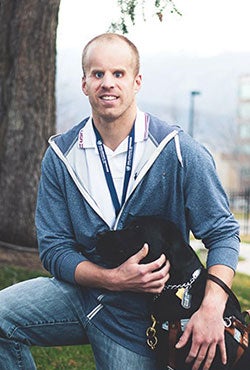
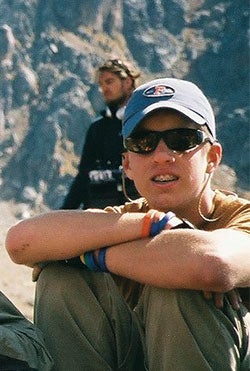
Coon learned to swim in a 25-yard lap pool using lane guides to stay on track. During his first session, he couldn’t even make it to the end. It would take a few months before he could swim 1,000 yards without stopping. Eventually though, Coon developed enough skill to complete his first half and full Ironman races with Melton in 2016. Since then, he’s gone on to complete 18 triathlons. And in 2018, he set the record for the first blind person to complete an Ironman in under 11 hours — more than 90 minutes faster than the average time it takes a sighted competitor to complete the race.
But in order to reach his goals, Coon knows he has to perform even better. He’s constantly working toward becoming a stronger swimmer. Completing fast swim times during lengthy practices is difficult, but race day swims will always be more challenging since they’re in open water. Tethered by a bungee cord wrapped around their thighs, Coon and his guide must work together to beat the clock and their competitors. Using cues such as shoulder taps and rib pokes, the duo must be great at communicating nonverbally with one another, something Coon has achieved with his current guide, Zack Goodman.
Coon and Goodman met in January 2018 at Camp No Sight No Limits, a high-performance training experience for athletes who are blind. The camp is based in San Diego, where Goodman is a doctoral student. Shortly before October 2018, Coon was planning to race the Sarasota-Bradenton Paratriathlon World Cup, but none of his usual guides could make it. Although he hadn’t worked with Goodman before, they had become friends and Coon decided to ask him to pair up.
With only a few days before the race to train together, Goodman and Coon took second, with the fastest time on the bike and one of the fastest runs of the day.
During their third and most recent race together, Coon was the only American to medal, earning bronze, at the Milan race for the World Paratriathlon Series. The accomplishment was surprising considering he was the lowest-ranked athlete in the race. He completed his fastest 5K, swim and the second-fastest bike session of the race, falling just 57 seconds short of silver medalist and ITU’s No. 1 visually impaired triathlete, Dave Ellis from Great Britain.

With Coon living in Colorado and Goodman in California, they don’t get a lot of time to train together, which is typical for blind athletes and their guides — some partners don’t get together until race day. But Coon and his guide speak frequently and keep tabs on each other’s progress through performance tracking apps. The standards Coon has for himself are pretty high, but he says he expects even more from his guide. They’ve got to be able to do more than keep up the pace to properly guide.
“One of the biggest challenges is finding someone who is significantly stronger than you. My rule of thumb is on my guide’s worst day, they need to be 10 percent faster than me on my best day,” Coon says.
Goodman is striving to meet Coon’s standards and plans to continue guiding him through the qualifying races during the next year. He even spent a couple weeks working with his partner at the training center. However, he recognizes there’s a possibility that Coon might eventually outpace him.
“I’ve never seen someone push themselves quite like Kyle pushes himself. I think that’s why it’s so much fun working with him,” Goodman says. “He’s done all these amazing feats that most sighted people probably can only dream of accomplishing in a lifetime.”
Coon’s Olympic Training Center coach Derick Williamson says it’s been incredible to witness his progress. Early on, Coon’s biggest mistake was pacing. Coon had a tendency to start out too hard on each run, bike and swim, leaving him burned out before he could complete his workouts.
“Just a couple months into training and I’ve already seen big improvements across the board. He’s a really talented runner. I don’t think he’s even come close to what he’s capable of,” Williamson says. “He’s learned to listen to his body, breathing and stride to know how to much more effectively push through the entire session.”
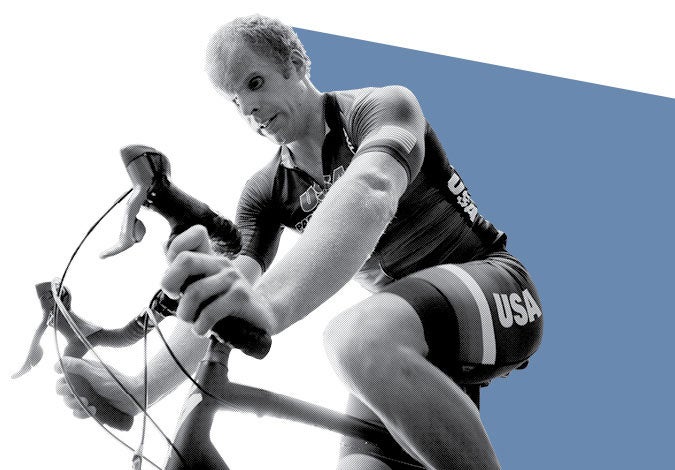
For now, Coon’s own sense of motivation and dedication is stronger than ever as he continues to step up his training and compete against the toughest opponents he’s ever had to face in increasingly high-profile races. With each workout and race completed, he’s focused on 2020. But if he doesn’t make it, he’ll push himself harder to make it to the 2024 Paralympic race.
“Some people say I just like to suffer, and they’re probably not too far from the truth,” Coon says. “I just love a challenge. I love pushing my mind and body to find the edge of my ability. I like seeing how much further I can push beyond my limits to improve.”
PHOTOS BY JONATHAN CHAVES